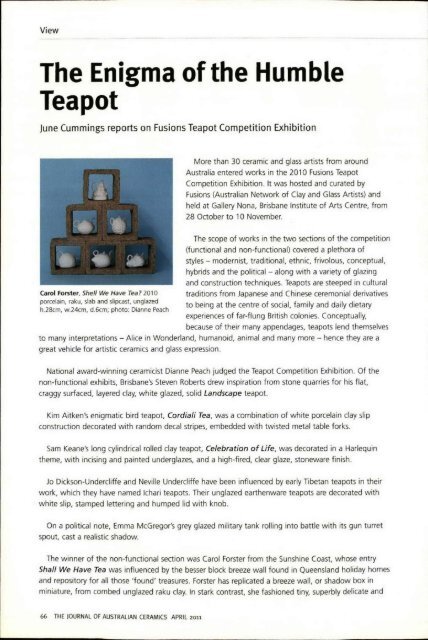The Journal of Australian Ceramics Vol 50 no 1 April 2011
You also want an ePaper? Increase the reach of your titles
YUMPU automatically turns print PDFs into web optimized ePapers that Google loves.
View<br />
<strong>The</strong> Enigma <strong>of</strong> the Humble<br />
Teapot<br />
June Cummings reports on Fusions Teapot Competition Exhibition<br />
More than 30 ceramic and glass artists from around<br />
Australia entered works in the 2010 Fusions Teapot<br />
Competition Exhibit ion. It was hosted and curated by<br />
Fusions (<strong>Australian</strong> Network <strong>of</strong> Clay and Glass Artists) and<br />
held at Gallery Nona, Brisbane Institute <strong>of</strong> Arts Centre, from<br />
28 October to 10 November.<br />
Carol Forster. Shell We Have Tea? 2010<br />
porcelain, raku, slab and slipcast. unglazed<br />
h.2Scm, w.24cm. d.6cm; photo: Dianne Peach<br />
<strong>The</strong> scope <strong>of</strong> works in the two sections <strong>of</strong> the competition<br />
(functional and <strong>no</strong>n-functional) covered a plethora <strong>of</strong><br />
styles - modernist, traditional, ethnic, frivolous, conceptual,<br />
hybrids and the political - along with a variety <strong>of</strong> glazing<br />
and construction techniques. Teapots are steeped in cultural<br />
traditions from Japanese and Chinese ceremonial derivatives<br />
to being at the centre <strong>of</strong> social , family and daily dietary<br />
experiences <strong>of</strong> far-flung British colonies. Conceptually,<br />
because <strong>of</strong> their many appendages, teapots lend themselves<br />
to many interpretations - Alice in Wonderland, huma<strong>no</strong>id, animal and many more - hence they are a<br />
great vehicle for artistic ceramics and glass expression.<br />
National award-winning ceramicist Dianne Peach judged the Teapot Competition Exhibition. Of the<br />
<strong>no</strong>n-functional exhibits, Brisbane's Steven Roberts drew inspiration from stone quarries for his flat,<br />
craggy surfaced, layered clay, white glazed, solid Landscape teapot.<br />
Kim Aitken's enigmatic bird teapot, Cordia Ii Tea , was a combination <strong>of</strong> white porcelain clay slip<br />
construction decorated with random decal stripes, embedded with twisted metal table forks.<br />
Sam Keane's long cylindrical rolled clay teapot, Celebration <strong>of</strong> Ufe, was decorated in a Harlequin<br />
theme, with incising and painted underglazes, and a high-fired, clear glaze, stoneware finish.<br />
Jo Dickson-Undercliffe and Neville Undercliffe have been influenced by early Tibetan teapots in their<br />
work, which they have named Ichari teapots. <strong>The</strong>ir unglazed earthenware teapots are decorated with<br />
white slip, stamped lettering and humped lid with k<strong>no</strong>b.<br />
On a political <strong>no</strong>te, Emma McGregor's grey glazed military tank rolling into battle with its gun turret<br />
spout, cast a realistic shadow.<br />
<strong>The</strong> winner <strong>of</strong> the <strong>no</strong>n-functional section was Carol Forster from the Sunshine Coast, whose entry<br />
Shall We Have Tea was influenced by the besser block breeze wall found in Queensland holiday homes<br />
and repository for all those 'found' treasures. Forster has replicated a breeze wall, or shadow box in<br />
miniature, from combed unglazed raku clay. In stark contrast, she fashioned tiny, superbly delicate and<br />
66 THE JOURNAL OF AUSTRALIAN CERAMICS APRil <strong>2011</strong>

















